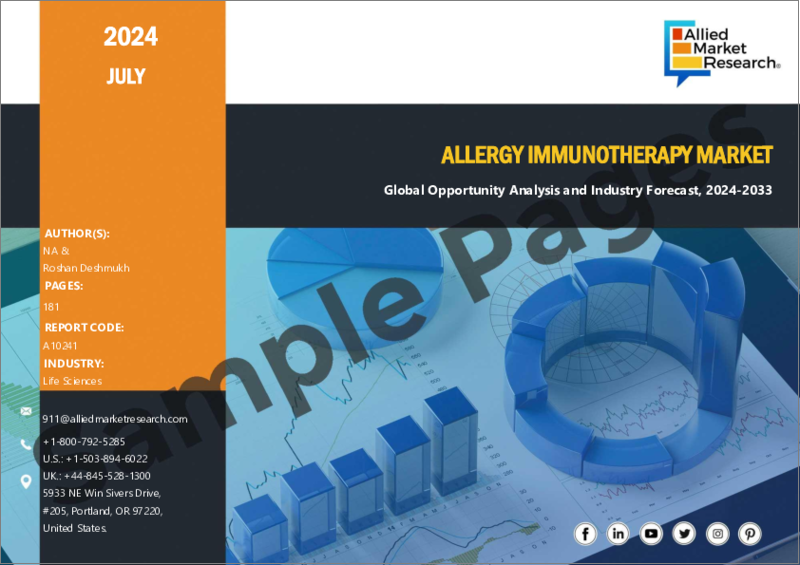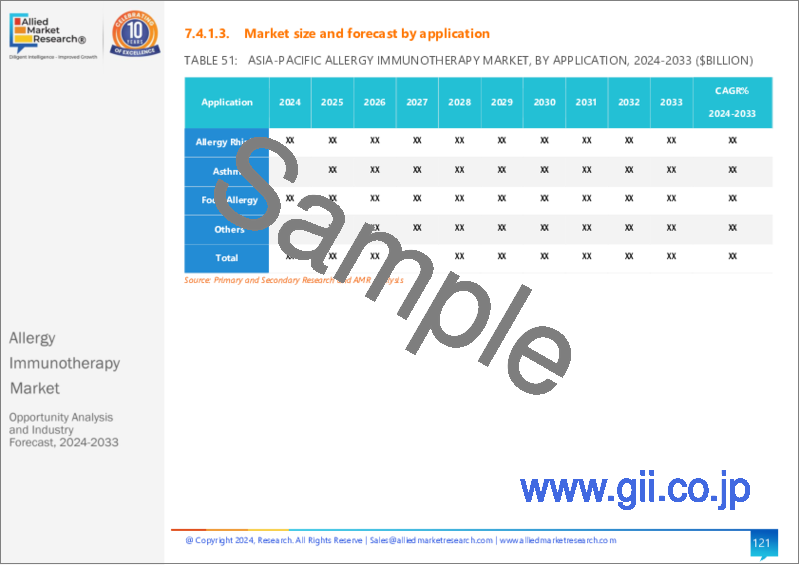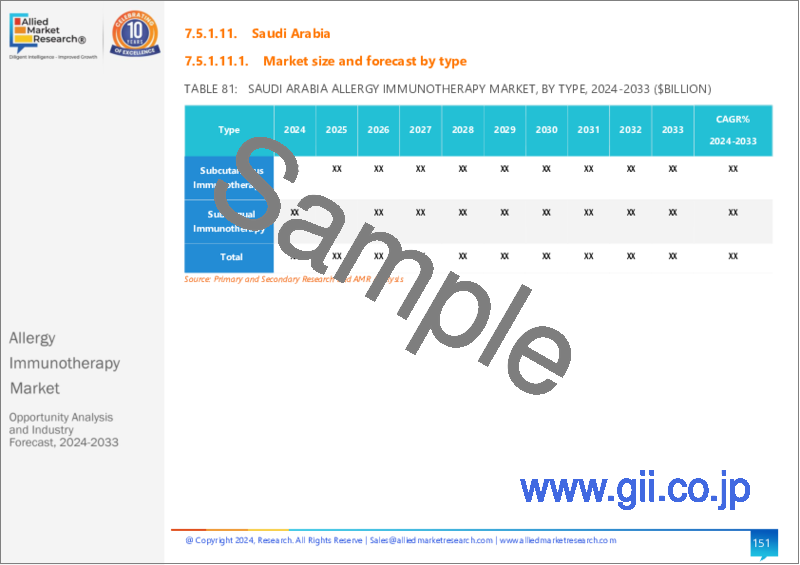|
|
市場調査レポート
商品コード
1566800
アレルギー免疫療法市場:タイプ別、用途別、流通チャネル別:世界の機会分析と産業予測、2024~2033年Allergy Immunotherapy Market By Type , By Application By Distribution Channel : Global Opportunity Analysis and Industry Forecast, 2024-2033 |
||||||
|
|||||||
| アレルギー免疫療法市場:タイプ別、用途別、流通チャネル別:世界の機会分析と産業予測、2024~2033年 |
|
出版日: 2024年07月10日
発行: Allied Market Research
ページ情報: 英文 216 Pages
納期: 2~3営業日
|
- 全表示
- 概要
- 目次
アレルギー免疫療法市場の2023年の市場規模は18億米ドルで、2024~2033年のCAGRは10.4%で、2033年には49億米ドルに達すると予測されています。
アレルギー免疫療法は、ハウスダストマイト、ハチ毒、イネ科花粉などの特定のアレルゲンに対するアレルギー反応の重症度を軽減することを目的としたアレルギーの予防治療です。この治療法では、アレルギーの原因となるアレルゲンの投与量を徐々に増やし、免疫系がアレルゲンに対して過敏にならないようにして、アレルギーの症状を軽減します。この治療法は、長期的な症状の緩和とアレルギー治療への依存度の低下につながります。
世界のアレルギー免疫療法市場の成長は、アレルギー性鼻炎、喘息、食物アレルギーなどのアレルギー疾患の有病率の憂慮すべき上昇と、患者や医療提供者のアレルギー免疫療法に対する意識の高まりが大きな原動力となっています。2011年にアレルギー白書で発表された研究によると、アレルギー性鼻炎の有病率は1%から18%、皮膚アレルギーは2%から10%、喘息は1%から20%と、さまざまな集団でみられます。さらに、アレルギー管理に対する効果的かつ長期的な解決策を求める患者の増加が、アレルギー免疫療法の需要を促進し、市場の成長に大きく寄与しています。さらに、個別化医療への傾向の高まりが、個々の患者のニーズや特定のアレルギーに対応するオーダーメイドの免疫療法治療の需要を促進し、市場の成長を促進しています。しかし、アレルギー免疫療法に関連する高額な費用や治療の副作用に対する懸念の増加が、市場の主要な阻害要因となっています。一方、新興市場における医療支出の増加は、アレルギー免疫療法のような先進的治療へのアクセスを容易にしており、予測期間中の市場成長に有益な機会を提供すると期待されています。さらに、舌下免疫療法の市場開拓や皮下免疫療法の製剤改良など、免疫療法技術の進歩が治療をより効果的で身近なものにしており、市場成長に新たな道を開くと期待されています。
世界のアレルギー免疫療法市場は、タイプ、用途、流通チャネル、地域に区分されます。タイプ別では、皮下免疫療法と舌下免疫療法に分類されます。用途別では、アレルギー性鼻炎、喘息、食物アレルギー、その他に分別されます。流通チャネル別では、病院薬局、小売店、オンライン薬局に細分化されます。地域別では、北米、欧州、アジア太平洋、ラテンアメリカ・中東・アフリカで分析されています。
主要調査結果
タイプ別では、皮下免疫療法(SCIT)セグメントが2023年に最も高い市場シェアを占めました。
用途別では、アレルギー性鼻炎セグメントが2033年までに最も高い成長率を示すと予測されます。
流通チャネル別では、病院薬局セグメントが予測期間中に高い注目を集めると予測されています。
地域別では、北米が今後数年間でアレルギー免疫療法市場を独占すると予測されます。
本レポートのカスタマイズが可能です(別途費用とスケジュールが必要です。)
- 規制ガイドライン
- クライアントの関心に応じた追加企業プロファイル
- 企業プロファイルの拡大リスト
- 償還シナリオ
目次
第1章 イントロダクション
第2章 エグゼクティブサマリー
第3章 市場情勢
- 市場の定義と範囲
- 主要調査結果
- 主要投資機会
- 主要成功戦略
- ポーターのファイブフォース分析
- 市場力学
- 促進要因
- 抑制要因
- 機会
第4章 アレルギー免疫療法市場:タイプ別
- 市場概要
- 皮下免疫療法
- 舌下免疫療法
第5章 アレルギー免疫療法市場:用途別
- 市場概要
- アレルギー性鼻炎
- 喘息
- 食物アレルギー
- その他
第6章 アレルギー免疫療法市場:流通チャネル別
- 市場概要
- 病院薬局
- 小売
- オンライン薬局
第7章 アレルギー免疫療法市場:地域別
- 市場概要
- 北米
- 主要市場動向と機会
- 米国のアレルギー免疫療法市場
- カナダのアレルギー免疫療法市場
- メキシコのアレルギー免疫療法市場
- 欧州
- 主要市場動向と機会
- フランスのアレルギー免疫療法市場
- ドイツのアレルギー免疫療法市場
- イタリアのアレルギー免疫療法市場
- スペインのアレルギー免疫療法市場
- 英国のアレルギー免疫療法市場
- その他の欧州のアレルギー免疫療法市場
- アジア太平洋
- 主要市場動向と機会
- 中国のアレルギー免疫療法市場
- 日本のアレルギー免疫療法市場
- インドのアレルギー免疫療法市場
- 韓国のアレルギー免疫療法市場
- オーストラリアのアレルギー免疫療法市場
- その他のアジア太平洋のアレルギー免疫療法市場
- ラテンアメリカ・中東・アフリカ
- 主要市場動向と機会
- ブラジルのアレルギー免疫療法市場
- 南アフリカのアレルギー免疫療法市場
- サウジアラビアのアレルギー免疫療法市場
- その他のラテンアメリカ・中東・アフリカのアレルギー免疫療法市場
第8章 競合情勢
- イントロダクション
- 主要成功戦略
- 主要10企業の製品マッピング
- 競合ダッシュボード
- 競合ヒートマップ
- 主要企業のポジショニング(2023年)
第9章 企業プロファイル
- Torii Pharmaceutical Co., Ltd.
- Biomay AG
- ALK-Abello A/S
- Allergy Therapeutics
- Allovate, LLC
- HAL Allergy Group
- Jubliant Pharma
- Leti Pharma
- Merck KGaA
- Stallergenes Greer
The allergy immunotherapy market was valued at $1.8 billion in 2023, and is projected to reach $4.9 billion by 2033, growing at a CAGR of 10.4% from 2024 to 2033.
Allergy immunotherapy is a preventative treatment for allergies that aims to mitigate the severity of allergic reactions to specific allergens such as house dust mites, bee venom, and grass pollens. This therapy involves gradual increase in administration of doses of the allergen to which an individual is allergic, thus making the immune systems less sensitive to the allergen and reducing the symptoms of allergy. The therapy can lead to long-term relief and decreased dependence on allergy medications.
The growth of the global allergy immunotherapy market is majorly driven by alarming rise in the prevalence of allergic conditions such as allergic rhinitis, asthma, and food allergies coupled with increase in awareness about allergy immunotherapy among patients and healthcare providers. Based on a 2011 study published in the White Book on Allergy, the prevalence rate of allergic rhinitis from 1% to 18%, skin allergies from 2% to 10%, and asthma ranges from 1% to 20% in various populations. Moreover, increase in preference of patients for effective and long-term solutions to allergy management fosters the demand for allergy immunotherapy, which significantly contributes toward the growth of the market. Furthermore, increase in trend toward personalized medicine is driving the demand for tailored immunotherapy treatments that address individual patient needs and specific allergies, which fosters the market growth. However, high cost of the associated with allergy immunotherapy and increase in concerns about the side effects of the treatment act as the key deterrent factors of the market. On the contrary, increase in healthcare expenditure in emerging markets is facilitating the access to advanced treatments like allergy immunotherapy, which is expected to offer remunerative opportunities for the growth of the market during the forecast period. Moreover, advancements in immunotherapy techniques, such as the development of sublingual immunotherapy and improved formulations of subcutaneous immunotherapy, are making treatments more effective and accessible, which are expected to open new avenues for the market growth.
The global allergy immunotherapy market is segmented into type, application, distribution channel, and region. On the basis of type, the market is categorized into subcutaneous immunotherapy and sublingual immunotherapy. By application, it is segregated into allergy rhinitis, asthma, food allergy, and others. Depending on distribution channel, it is fragmented into hospital pharmacies, retail, and online pharmacies. Region wise, it is analyzed across North America, Europe, Asia-Pacific, and LAMEA.
Key Findings
On the basis of type, the subcutaneous immunotherapy (SCIT) segment held the highest market share in 2023.
By application, the allergic rhinitis segment is expected to exhibit highest growth rate by 2033.
Depending on distribution channel,, the hospital pharmacies segment is anticipated to gain high prominence during the forecast period.
Region wise, North America is projected to dominate the allergy immunotherapy market in the coming years.
Competition Analysis
Competitive analysis and profiles of the major players in the global allergy immunotherapy market include Torii Pharmaceutical Co., Ltd., Biomay AG, ALK-Abello A/S, Allergy Therapeutics, Allovate, LLC, HAL Allergy Group, Jubliant Pharma, Leti Pharma, Merck KGaA, and Stallergenes Greer. These major players have adopted various key development strategies such as business expansion, new product launches, and partnerships to sustain the intense competition and garner a strong foothold in the global market.
Additional benefits you will get with this purchase are:
- Quarterly Update and* (only available with a corporate license, on listed price)
- 5 additional Company Profile of client Choice pre- or Post-purchase, as a free update.
- Free Upcoming Version on the Purchase of Five and Enterprise User License.
- 16 analyst hours of support* (post-purchase, if you find additional data requirements upon review of the report, you may receive support amounting to 16 analyst hours to solve questions, and post-sale queries)
- 15% Free Customization* (in case the scope or segment of the report does not match your requirements, 15% is equivalent to 3 working days of free work, applicable once)
- Free data Pack on the Five and Enterprise User License. (Excel version of the report)
- Free Updated report if the report is 6-12 months old or older.
- 24-hour priority response*
- Free Industry updates and white papers.
Possible Customization with this report (with additional cost and timeline, please talk to the sales executive to know more)
- Regulatory Guidelines
- Additional company profiles with specific to client's interest
- Expanded list for Company Profiles
- Reimbursement Scenario
Key Market Segments
By Type
- Subcutaneous Immunotherapy
- Sublingual Immunotherapy
By Application
- Allergy Rhinitis
- Asthma
- Food Allergy
- Others
By Distribution Channel
- Hospital Pharmacies
- Retail
- Online Pharmacies
By Region
- North America
- U.S.
- Canada
- Mexico
- Europe
- France
- Germany
- Italy
- Spain
- UK
- Rest of Europe
- Asia-Pacific
- China
- Japan
- India
- South Korea
- Australia
- Rest of Asia-Pacific
- LAMEA
- Brazil
- South Africa
- Saudi Arabia
- Rest of LAMEA
Key Market Players:
- Torii Pharmaceutical Co., Ltd.
- Biomay AG
- ALK-Abello A/S
- Allergy Therapeutics
- Allovate, LLC
- HAL Allergy Group
- Jubliant Pharma
- Leti Pharma
- Merck KGaA
- Stallergenes Greer
TABLE OF CONTENTS
CHAPTER 1: INTRODUCTION
- 1.1. Report Description
- 1.2. Key Market Segments
- 1.3. Key Benefits
- 1.4. Research Methodology
- 1.4.1. Primary Research
- 1.4.2. Secondary Research
- 1.4.3. Analyst Tools and Models
CHAPTER 2: EXECUTIVE SUMMARY
- 2.1. CXO Perspective
CHAPTER 3: MARKET LANDSCAPE
- 3.1. Market Definition and Scope
- 3.2. Key Findings
- 3.2.1. Top Investment Pockets
- 3.2.2. Top Winning Strategies
- 3.3. Porter's Five Forces Analysis
- 3.3.1. Bargaining Power of Suppliers
- 3.3.2. Threat of New Entrants
- 3.3.3. Threat of Substitutes
- 3.3.4. Competitive Rivalry
- 3.3.5. Bargaining Power among Buyers
- 3.4. Market Dynamics
- 3.4.1. Drivers
- 3.4.2. Restraints
- 3.4.3. Opportunities
CHAPTER 4: ALLERGY IMMUNOTHERAPY MARKET, BY TYPE
- 4.1. Market Overview
- 4.1.1 Market Size and Forecast, By Type
- 4.2. Subcutaneous Immunotherapy
- 4.2.1. Key Market Trends, Growth Factors and Opportunities
- 4.2.2. Market Size and Forecast, By Region
- 4.2.3. Market Share Analysis, By Country
- 4.3. Sublingual Immunotherapy
- 4.3.1. Key Market Trends, Growth Factors and Opportunities
- 4.3.2. Market Size and Forecast, By Region
- 4.3.3. Market Share Analysis, By Country
CHAPTER 5: ALLERGY IMMUNOTHERAPY MARKET, BY APPLICATION
- 5.1. Market Overview
- 5.1.1 Market Size and Forecast, By Application
- 5.2. Allergy Rhinitis
- 5.2.1. Key Market Trends, Growth Factors and Opportunities
- 5.2.2. Market Size and Forecast, By Region
- 5.2.3. Market Share Analysis, By Country
- 5.3. Asthma
- 5.3.1. Key Market Trends, Growth Factors and Opportunities
- 5.3.2. Market Size and Forecast, By Region
- 5.3.3. Market Share Analysis, By Country
- 5.4. Food Allergy
- 5.4.1. Key Market Trends, Growth Factors and Opportunities
- 5.4.2. Market Size and Forecast, By Region
- 5.4.3. Market Share Analysis, By Country
- 5.5. Others
- 5.5.1. Key Market Trends, Growth Factors and Opportunities
- 5.5.2. Market Size and Forecast, By Region
- 5.5.3. Market Share Analysis, By Country
CHAPTER 6: ALLERGY IMMUNOTHERAPY MARKET, BY DISTRIBUTION CHANNEL
- 6.1. Market Overview
- 6.1.1 Market Size and Forecast, By Distribution Channel
- 6.2. Hospital Pharmacies
- 6.2.1. Key Market Trends, Growth Factors and Opportunities
- 6.2.2. Market Size and Forecast, By Region
- 6.2.3. Market Share Analysis, By Country
- 6.3. Retail
- 6.3.1. Key Market Trends, Growth Factors and Opportunities
- 6.3.2. Market Size and Forecast, By Region
- 6.3.3. Market Share Analysis, By Country
- 6.4. Online Pharmacies
- 6.4.1. Key Market Trends, Growth Factors and Opportunities
- 6.4.2. Market Size and Forecast, By Region
- 6.4.3. Market Share Analysis, By Country
CHAPTER 7: ALLERGY IMMUNOTHERAPY MARKET, BY REGION
- 7.1. Market Overview
- 7.1.1 Market Size and Forecast, By Region
- 7.2. North America
- 7.2.1. Key Market Trends and Opportunities
- 7.2.2. Market Size and Forecast, By Type
- 7.2.3. Market Size and Forecast, By Application
- 7.2.4. Market Size and Forecast, By Distribution Channel
- 7.2.5. Market Size and Forecast, By Country
- 7.2.6. U.S. Allergy Immunotherapy Market
- 7.2.6.1. Market Size and Forecast, By Type
- 7.2.6.2. Market Size and Forecast, By Application
- 7.2.6.3. Market Size and Forecast, By Distribution Channel
- 7.2.7. Canada Allergy Immunotherapy Market
- 7.2.7.1. Market Size and Forecast, By Type
- 7.2.7.2. Market Size and Forecast, By Application
- 7.2.7.3. Market Size and Forecast, By Distribution Channel
- 7.2.8. Mexico Allergy Immunotherapy Market
- 7.2.8.1. Market Size and Forecast, By Type
- 7.2.8.2. Market Size and Forecast, By Application
- 7.2.8.3. Market Size and Forecast, By Distribution Channel
- 7.3. Europe
- 7.3.1. Key Market Trends and Opportunities
- 7.3.2. Market Size and Forecast, By Type
- 7.3.3. Market Size and Forecast, By Application
- 7.3.4. Market Size and Forecast, By Distribution Channel
- 7.3.5. Market Size and Forecast, By Country
- 7.3.6. France Allergy Immunotherapy Market
- 7.3.6.1. Market Size and Forecast, By Type
- 7.3.6.2. Market Size and Forecast, By Application
- 7.3.6.3. Market Size and Forecast, By Distribution Channel
- 7.3.7. Germany Allergy Immunotherapy Market
- 7.3.7.1. Market Size and Forecast, By Type
- 7.3.7.2. Market Size and Forecast, By Application
- 7.3.7.3. Market Size and Forecast, By Distribution Channel
- 7.3.8. Italy Allergy Immunotherapy Market
- 7.3.8.1. Market Size and Forecast, By Type
- 7.3.8.2. Market Size and Forecast, By Application
- 7.3.8.3. Market Size and Forecast, By Distribution Channel
- 7.3.9. Spain Allergy Immunotherapy Market
- 7.3.9.1. Market Size and Forecast, By Type
- 7.3.9.2. Market Size and Forecast, By Application
- 7.3.9.3. Market Size and Forecast, By Distribution Channel
- 7.3.10. UK Allergy Immunotherapy Market
- 7.3.10.1. Market Size and Forecast, By Type
- 7.3.10.2. Market Size and Forecast, By Application
- 7.3.10.3. Market Size and Forecast, By Distribution Channel
- 7.3.11. Rest of Europe Allergy Immunotherapy Market
- 7.3.11.1. Market Size and Forecast, By Type
- 7.3.11.2. Market Size and Forecast, By Application
- 7.3.11.3. Market Size and Forecast, By Distribution Channel
- 7.4. Asia-Pacific
- 7.4.1. Key Market Trends and Opportunities
- 7.4.2. Market Size and Forecast, By Type
- 7.4.3. Market Size and Forecast, By Application
- 7.4.4. Market Size and Forecast, By Distribution Channel
- 7.4.5. Market Size and Forecast, By Country
- 7.4.6. China Allergy Immunotherapy Market
- 7.4.6.1. Market Size and Forecast, By Type
- 7.4.6.2. Market Size and Forecast, By Application
- 7.4.6.3. Market Size and Forecast, By Distribution Channel
- 7.4.7. Japan Allergy Immunotherapy Market
- 7.4.7.1. Market Size and Forecast, By Type
- 7.4.7.2. Market Size and Forecast, By Application
- 7.4.7.3. Market Size and Forecast, By Distribution Channel
- 7.4.8. India Allergy Immunotherapy Market
- 7.4.8.1. Market Size and Forecast, By Type
- 7.4.8.2. Market Size and Forecast, By Application
- 7.4.8.3. Market Size and Forecast, By Distribution Channel
- 7.4.9. South Korea Allergy Immunotherapy Market
- 7.4.9.1. Market Size and Forecast, By Type
- 7.4.9.2. Market Size and Forecast, By Application
- 7.4.9.3. Market Size and Forecast, By Distribution Channel
- 7.4.10. Australia Allergy Immunotherapy Market
- 7.4.10.1. Market Size and Forecast, By Type
- 7.4.10.2. Market Size and Forecast, By Application
- 7.4.10.3. Market Size and Forecast, By Distribution Channel
- 7.4.11. Rest of Asia-Pacific Allergy Immunotherapy Market
- 7.4.11.1. Market Size and Forecast, By Type
- 7.4.11.2. Market Size and Forecast, By Application
- 7.4.11.3. Market Size and Forecast, By Distribution Channel
- 7.5. LAMEA
- 7.5.1. Key Market Trends and Opportunities
- 7.5.2. Market Size and Forecast, By Type
- 7.5.3. Market Size and Forecast, By Application
- 7.5.4. Market Size and Forecast, By Distribution Channel
- 7.5.5. Market Size and Forecast, By Country
- 7.5.6. Brazil Allergy Immunotherapy Market
- 7.5.6.1. Market Size and Forecast, By Type
- 7.5.6.2. Market Size and Forecast, By Application
- 7.5.6.3. Market Size and Forecast, By Distribution Channel
- 7.5.7. South Africa Allergy Immunotherapy Market
- 7.5.7.1. Market Size and Forecast, By Type
- 7.5.7.2. Market Size and Forecast, By Application
- 7.5.7.3. Market Size and Forecast, By Distribution Channel
- 7.5.8. Saudi Arabia Allergy Immunotherapy Market
- 7.5.8.1. Market Size and Forecast, By Type
- 7.5.8.2. Market Size and Forecast, By Application
- 7.5.8.3. Market Size and Forecast, By Distribution Channel
- 7.5.9. Rest of LAMEA Allergy Immunotherapy Market
- 7.5.9.1. Market Size and Forecast, By Type
- 7.5.9.2. Market Size and Forecast, By Application
- 7.5.9.3. Market Size and Forecast, By Distribution Channel
CHAPTER 8: COMPETITIVE LANDSCAPE
- 8.1. Introduction
- 8.2. Top Winning Strategies
- 8.3. Product Mapping of Top 10 Player
- 8.4. Competitive Dashboard
- 8.5. Competitive Heatmap
- 8.6. Top Player Positioning, 2023
CHAPTER 9: COMPANY PROFILES
- 9.1. Torii Pharmaceutical Co., Ltd.
- 9.1.1. Company Overview
- 9.1.2. Key Executives
- 9.1.3. Company Snapshot
- 9.1.4. Operating Business Segments
- 9.1.5. Product Portfolio
- 9.1.6. Business Performance
- 9.1.7. Key Strategic Moves and Developments
- 9.2. Biomay AG
- 9.2.1. Company Overview
- 9.2.2. Key Executives
- 9.2.3. Company Snapshot
- 9.2.4. Operating Business Segments
- 9.2.5. Product Portfolio
- 9.2.6. Business Performance
- 9.2.7. Key Strategic Moves and Developments
- 9.3. ALK-Abello A/S
- 9.3.1. Company Overview
- 9.3.2. Key Executives
- 9.3.3. Company Snapshot
- 9.3.4. Operating Business Segments
- 9.3.5. Product Portfolio
- 9.3.6. Business Performance
- 9.3.7. Key Strategic Moves and Developments
- 9.4. Allergy Therapeutics
- 9.4.1. Company Overview
- 9.4.2. Key Executives
- 9.4.3. Company Snapshot
- 9.4.4. Operating Business Segments
- 9.4.5. Product Portfolio
- 9.4.6. Business Performance
- 9.4.7. Key Strategic Moves and Developments
- 9.5. Allovate, LLC
- 9.5.1. Company Overview
- 9.5.2. Key Executives
- 9.5.3. Company Snapshot
- 9.5.4. Operating Business Segments
- 9.5.5. Product Portfolio
- 9.5.6. Business Performance
- 9.5.7. Key Strategic Moves and Developments
- 9.6. HAL Allergy Group
- 9.6.1. Company Overview
- 9.6.2. Key Executives
- 9.6.3. Company Snapshot
- 9.6.4. Operating Business Segments
- 9.6.5. Product Portfolio
- 9.6.6. Business Performance
- 9.6.7. Key Strategic Moves and Developments
- 9.7. Jubliant Pharma
- 9.7.1. Company Overview
- 9.7.2. Key Executives
- 9.7.3. Company Snapshot
- 9.7.4. Operating Business Segments
- 9.7.5. Product Portfolio
- 9.7.6. Business Performance
- 9.7.7. Key Strategic Moves and Developments
- 9.8. Leti Pharma
- 9.8.1. Company Overview
- 9.8.2. Key Executives
- 9.8.3. Company Snapshot
- 9.8.4. Operating Business Segments
- 9.8.5. Product Portfolio
- 9.8.6. Business Performance
- 9.8.7. Key Strategic Moves and Developments
- 9.9. Merck KGaA
- 9.9.1. Company Overview
- 9.9.2. Key Executives
- 9.9.3. Company Snapshot
- 9.9.4. Operating Business Segments
- 9.9.5. Product Portfolio
- 9.9.6. Business Performance
- 9.9.7. Key Strategic Moves and Developments
- 9.10. Stallergenes Greer
- 9.10.1. Company Overview
- 9.10.2. Key Executives
- 9.10.3. Company Snapshot
- 9.10.4. Operating Business Segments
- 9.10.5. Product Portfolio
- 9.10.6. Business Performance
- 9.10.7. Key Strategic Moves and Developments






